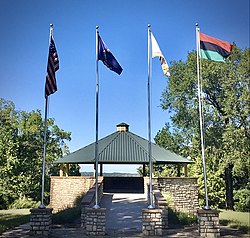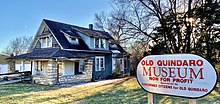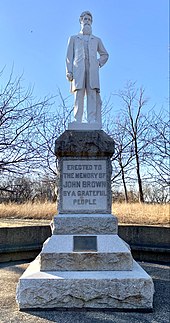This article needs additional citations for
verification. (March 2022) |
Quindaro Townsite | |
 | |
| Location | Kansas City, KS |
|---|---|
| Coordinates | 39°09′14″N 94°39′42″W / 39.15389°N 94.66167°W |
| Built | 1857 |
| NRHP reference No. | 02000547 [1] |
| Added to NRHP | May 22, 2002 |
Quindaro Townsite is a former settlement, then ghost town, and now an archaeological district. It is around North 27th Street and the Missouri Pacific Railroad tracks in Kansas City, Kansas. It was placed on the National Register of Historic Places on May 22, 2002.
The townsite was purchased and organized in 1856 from and by Wyandots for development as a port-of-entry for Free Staters settling further within the Kansas Territory, [2] with construction starting in 1857. The boomtown population peaked at 600, rapidly settled by migrants. They were supported by the New England Emigrant Aid Company, who were trying to help secure Kansas as a free territory. [3] One of several villages hugging the narrow bank of the Missouri River under the bluffs, the town was established as part of the resistance to stop the westward spread of slavery. Quindaro's people also aided escaped slaves from Missouri as a "station" on the Underground Railroad.
After Kansas was established as a free state, there was less unique need for the port and the growth slowed in the commercial district. At the same time the economy in Kansas suffered from over-speculation.
In 1862 classes were started for children of former slaves, and in 1865 a group of men chartered Quindaro Freedman's School (later Western University), the first black school west of the Mississippi River. Former slaves continued to gather in the residential community, which became mostly African American by the late 19th century. The area was incorporated into Kansas City in the early 20th century. Western University closed in 1943.
The overall town sharply declined with a nationwide economic depression and with the American Civil War. The lower commercial townsite was abandoned and became overgrown. It was rediscovered during archaeological study in the late 1980s, which revealed many aspects of the 1850s town. [4] The only structure surviving from Western University and Quindaro is a full-size statue of abolitionist John Brown. In 1978 the John Brown Memorial Plaza was dedicated.
The John D. Dingell Jr. Conservation, Management, and Recreation Act designated it the Quindaro Townsite National Commemorative Site in 2019, allowing the National Park Service to provide technical and financial assistance for preservation and education.
History
Foundation



With the Kansas–Nebraska Act, the Kansas Territory was opened to settlement with the promise that the settlers would vote to decide whether the state would enter the Union as a Slave State or a Free State. The New England Emigrant Aid Company (NEEAC) had already aided more than 1,200 settlers in their migration, hoping to secure Kansas as a free territory. The decision was left to the vote of the territory's residents. [3]
Abolitionists and Free-Staters approached the Wyandot town, Wyandotte City, to establish a town company to create a Free-State port to counter the pro-slavery ports of Leavenworth, Atchison, and Kansas City, Missouri. However, just such a town company had already been founded within Wyandotte City, with the following persons representing the Quindaro Town Company: [5] [6]
- President: Joel Walker, brother of William Walker, Wyandot Chief and Territorial Governor
- Vice-president: Abelard Guthrie, attorney, land agent, and Wyandot by marriage to Nancy Quindaro Brown
- Treasurer: Charles Robinson, financial agent of the NEEAC and future governor of Kansas
- Secretary: S. N. Simpson, also of the NEEAC
In 1855, the land of the Wyandot Reservation had been divided among the families. The Quindaro Town Company was so named because it bought Nancy Quindaro's land allotment for the townsite. A common female name within the Wyandot, Quindaro means "bundle of sticks" or "strength through numbers", in the Wyandot language. [7] [8]
Quindaro was one of several competing small ports on the Missouri River. Planners seeking to establish a Free-State port noted the site's advantages:
At a point six miles above the mouth of the Kansas river, on Wyandotte Indian land, they found a fine natural rock ledge where the river ran along the bank six to twelve feet deep, making a convenient landing. Plenty of wood and rock were at hand for building purposes and fertile land was adjacent. [9]: 305

Construction started in January 1857, and the town soon contained numerous stone houses and starts of several businesses. Its sawmill was the largest in Kansas. [9] The lower townsite near the river was the commercial core, and most residences were higher on the bluff, at the upper townsite. In the first year, there were 100 buildings completed, many of stone and brick, "including hotels, Dry Goods, Hardware and Grocery stores, a Church [two churches] and School house". [10] Tribal natives living there were not dispossessed and became a part of Quindaro. [11]
John Morgan Walden was one of many young men attracted to Quindaro, where he founded a Free-Soil paper called Quindaro Chindowan. The name Chindowan was a Wyandot word for "leader". [9]: 305–308 Walden also was a missionary to freedmen and later became a bishop in the Methodist Church. [4]
Underground Railroad
After the Kansas–Nebraska Act was passed in 1854, a western branch of the Underground Railroad was developed in Kansas. Quindaro was linked to this and the Lane Trail. It provided a new route of escape for slaves from Missouri. It was most important in the years before Kansas was established as a free state in 1861. Quindaro became a legendary port for fugitive slaves and, later, blacks arriving as contraband (escapees) during the American Civil War.
Clarina Nichols [12] was a writer for the Quindaro Chindowan, a friend of Susan B. Anthony, and fellow crusader for the rights of women and children. [13] She was an important Conductor and "Station Master" of the Underground Railroad in Quindaro. She left a letter about a time when a freedom seeker named Caroline was brought to her house. [14] Fourteen slave hunters, including her slave master, were camped on the edge of town and looking for her. Caroline was hidden in an empty and elaborately disguised cistern overnight, and then sent on the road north as soon as it was safe. [7] [15]
Decline
Having reached a peak population of 600, the booming commercial townsite quickly went bust due to a nationwide economic depression that afflicted much of Kansas, and a failed campaign to attract a railroad. With the American Civil War, the Union Army recruited away many young men, and only few farming families stayed. The lower town site at the riverside was largely abandoned. [7] Later African-American arrivals settled in the upper town on the bluff. The economy declined because of over-speculation in Kansas, and in 1862 the legislature withdrew the town charter, putting the town corporation out of business. [9]
Difficulties in reaching the interior from below the bluff hampered commerce, and changes after the war reduced the need for the port. In addition, the topography was difficult, surrounding Wyandot land limited expansion, and problems with land titles inhibited growth. After being abandoned, the early lower commercial townsite became overgrown, with some areas covered by earth falling from the bluffs. Historians recall it overall as a ghost town. In the early 20th century, all of the townsite was incorporated into Kansas City, Kansas.
Western University
Even before the war ended, however, Eben Blachly, a Presbyterian, in 1862 started classes in his home for the children of former slaves. The Reverend Eben Blachly had been a farmer in Dane County, Wisconsin, one of the early pioneers who had migrated from Pennsylvania. According to Blachly family legend, he was nearly hung as a "Northern spy" while trying to find his oldest son, a Union soldier who had been captured by the Confederates. With the noose around his neck he asked to say some final words, a wish that was granted by the rebels. After praying out loud for the welfare of their souls (the rebels were about to hang an innocent man), they took the noose off his neck and sent him home to Wisconsin. This traumatic experience, apparently, led him to dedicate his life to helping former slaves by organizing the Quindaro Freedman's School (later Western University), which was chartered in 1867, and which he ran until his death in 1877. It was a historically black university (HBCU) started at the upper town site of Quindaro. Its principal in 1872, when the state legislature added a four-year normal school, was Charles Henry Langston, a leading black abolitionist and activist, educator, and politician in Ohio and Kansas.
In the early 20th century, Western University became known for its outstanding music program. Music historian Helen Walker-Hill, writing in the Black Music Journal, states that "Western University at Quindaro, Kansas, was probably the earliest black school west of the Mississippi and the best black musical training center in the Midwest for almost thirty years during the 1900s through the 1920s." [16]
In the early 1900s, Western University also added a full industrial curriculum, with buildings to house livestock and another for a laundry. Later a building was added for teaching auto mechanics and repair. The university closed in 1943, and aside from its statue of abolitionist John Brown, nothing but cornerstones of some early buildings remains. Some buildings were lost to fire, others to demolition as sites were redeveloped. The last structures remaining were three faculty houses, which were demolished near the end of the 20th century. [10] One houses the Old Quindaro Museum. The Quindaro Underground Railroad Museum is located nearby in the Vernon Multipurpose Center, the former Quindaro Colored School.
Archeological and oral history projects
An archaeological study in 1987–1988, required for a public project, revealed the remains of the 1850s townsite. The foundations of 20 main buildings, two outbuildings, three wells, and one cistern were found. From original maps, newspapers, and letters, researchers know other structures existed. Because of the significance of the town, the townsite has been designated an archaeological district on the National Register of Historic Places. A number of public history projects have been undertaken to engage the public and share the discoveries. [10]
In 1993, Kansas State University, in cooperation with the Mayor's Underground Railroad Advisory Commission and the Quindaro Town Preservation Society, commissioned graduate students to develop proposals for a park to incorporate the ruins and archaeology of Quindaro. Their 13 proposals were presented at a major public meeting, displayed at the state capitol's rotunda, and presented in numerous venues around the state. While consensus is lacking on how to develop a park, the plans have been successful in engaging the public and teaching history. [4]
In 1996, the University of Kansas sponsored a major oral history project, in which more than a dozen professors interviewed people among the nearby African-American community for their family accounts of Quindaro. [4] The history and legends of the settlement lived in stories told by their descendants and friends. Because of the brief life of Quindaro, it was not much documented in written records. Public history projects have identified some new sources.
In December 2007, the Kansas Humanities Council awarded a grant to the Concerned Citizens of Old Quindaro, Kansas City, for In Unity There is Strength: The African American Experience, an exhibit to interpret the history of former slaves who escaped to Quindaro from across the Missouri River in the mid-19th century. The exhibit was to address religious, educational, and business elements of the community which they created. [17]
In 2018, Quindaro community stakeholders including historians, archeologists, scholars, and activists began resolving decades of struggle over how to strategically manage the historical site. [18]
References
- ^ "National Register Information System". National Register of Historic Places. National Park Service. January 23, 2007.
-
^ Morgan, Perl Wilbur (1911).
History of Wyandotte County, Kansas: And Its People. Vol. 1.
The Lewis Publishing Company. pp. 102–103. Retrieved March 20, 2023.
The towns of Kansas City [Missouri], Leavenworth, and Atchinson were concidered pro-slavery ports. The Free State people wanted a "port of entry of their own, ... The land was purchased from wome Wyandot Indians ... 1856.
- ^ a b "Judgment Day, Part 4: 1853-1861". Africans in America. PBS. Retrieved March 13, 2022.
- ^ a b c d Swann, Michael M. (1998). "The Educational Value of Quindaro Townsite in the 21st Century" (PDF). Cultural Resource Management. US Dept of the Interior, National Park Service, Cultural Resources. p. 34. Retrieved March 13, 2022.
- ^ Morgan, p. 106.
-
^ Larry Hancks.
"Quindaro 1856-1862 and 1881-1948". wyandot.org. Wyandot Nation of Kansas. Retrieved March 20, 2023.
... and S. N. Simpson, also of Lawrence, who was company secretary.
- ^ a b c "Quindaro". Kansapedia. Kansas Historical Society. 2019 [2010]. Retrieved March 15, 2021.
- ^ Kansas City Kansan (May 8, 1938). "History of Old Quindaro Recalled as School Plans Eightieth Anniversary Fete". Kansas Historical Quarterly. Kansas Historical Collections. Vol. VIII, no. 1. Kansas State Historical Society. p. 226. Retrieved March 13, 2022.
- ^ a b c d Farley, Alan W. (1956). "Annals of Quindaro: A Kansas Ghost Town". Kansas Historical Quarterly. 22 (4): 305–320. Archived from the original on October 19, 2003. Retrieved March 15, 2021.
- ^ a b c "Mrs. C.I.H. Nichol's Letter, Part III". Wyandotte Gazette. December 22, 1888. Archived from the original on July 8, 2001. Retrieved December 20, 2008 – via Quindaro, Kansas on the Underground Railroad; Kansas City, Kansas Public Library.
- ^ Lause, Mark A. (2018). "Survival and Persistence: The Lineages and Legacies of the Early American Movement". Long Road to Harpers Ferry: The Rise of the First American Left. London: Pluto Press. pp. 191–200. doi: 10.2307/j.ctv69tg5b.13. ISBN 9780745337609. JSTOR j.ctv69tg5b.13. S2CID 240199051.
- ^ "Clarina Nichols - Kansapedia - Kansas Historical Society".
- ^ "Bold American stories from Quindaro Press". Bold American stories from Quindaro Press. Retrieved October 15, 2021.
- ^ "Myth of the escape tunnel". lifedocumentaries.com. Archived from the original on December 27, 2013.
- ^ "Kansas Women and the Underground Railroad". lifedocumentaries.com. Archived from the original on December 27, 2013.
- ^ Walker-Hill, Helen (Spring 2006). "Western University at Quindaro, Kansas and its legacy of pioneering musical women". Black Music Research Journal. 26 (1): 7–37. JSTOR 25433761.
- ^ "Kansas Humanities Council Awards Fall Grants". Kansas Humanities Council. December 3, 2007. Retrieved December 20, 2008.
- ^ Ziegler, Laura (April 19, 2018). "Advocates Say Consensus Over Quindaro Ruins May Finally Lead To Preservation". NPR. Retrieved March 13, 2022.
Further reading
- Collins, Steve; Collins, Dorothy (October 2010). "Quindaro Underground Railroad: A Unique Ethnic Unity in America's Past" (PDF). Kansas City Kansas Community College.
- Greenbaum, Susan D. (1982). The Afro-American Community in Kansas City, Kansas: A History. Kansas City, Kansas Community Development Program. City of Kansas City, Kansas. OCLC 9662086.
- Magnuson, Carl (1990). "The Town of Quindaro: From Community Narrative to Public Debate". Mid-America Folklore. No. 2. Springfield, MO: Ozark States Folklore Society; English Dept., Southwest Missouri State University. pp. 91–107. ISSN 0275-6013. OCLC 5235296.
- Mudge, Melville, ed. (Winter 1990). "Benjamin Franklin Mudge: A Letter from Quindaro". Kansas History. Vol. 13, no. 4. pp. 218–222. Retrieved March 13, 2022.
- "Quindaro Question: Will the Historic Site Be Saved or Allowed to Fade Away Forever?". Star Magazine. Kansas City Star. June 6, 1999. p. 8. Archived from the original on February 19, 2015.
- Schmits, Larry (1988). "Quindaro: Kansas Territorial Free-State Port on the Missouri River". The Missouri Archaeologist. Vol. 49. pp. 89–145.
- "Quindaro History". Kansas City, Kansas Public Library.
- Farley, Alan W. (1956). "Annals of Quindaro: A Kansas Ghost Town". Kansas History: A Journal of the Central Plains. Vol. 22. pp. 305–320 – via Kansas Historical Society.
External links
- Abolitionism in the United States
- African-American history of Kansas
- Archaeological sites on the National Register of Historic Places in Kansas
- Geography of Wyandotte County, Kansas
- History of Kansas City, Kansas
- Native American history of Kansas
- 1857 establishments in Kansas Territory
- National Register of Historic Places in Kansas City, Kansas
- Bleeding Kansas
- Populated places on the Underground Railroad
- Tourist attractions in Wyandotte County, Kansas
- Populated places in Kansas established by African Americans

